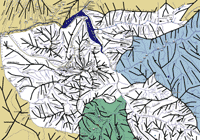The Western Tien-Shan (Tyan-Shan) is
nominated for inclusion in the UNESCO World Nature Heritage List.
This was noted at the summit of experts held by the United Nations
Education, Science and Culture Organization (UNESCO) in Tashkent. It
addressed the procedure of applying for inclusion of this piece of
nature into the World Heritage List. Only thoroughly selected
territories are included in this list. In return, these areas are
rendered the overall and immediate support of the international
community, they are in priority for attraction of investments to
preserve the heritage objects and have additional guarantees for safety
and integrity of unique natural complexes.
The Western Tien-Shan (Tyan-Shan) mountains have a rich animal and plant kingdom
with the considerable share of endemic species and communities that
cannot be found anywhere in the globe. They include Apollo butterfly,
red wolf, snow leopard, Menzibre marmot, Karatau subspecies of wild ram,
black vulture, saker falcon, Egyptian vulture.

Tens of animal and plant species are included in the Red List of the
International Union for Nature Protection and the Red Book of the
Republic of Uzbekistan. The careful treatment of them is important for
preservation of biodiversity and gene pool and it is of exceptional
value for science and selection. This is obvious, given the fact that
the Western Tien-Shan (Tyan-Shan) is one of the world centers of origin of nut wood,
fruit and other cultivated plants. Numerous types of wild parents of
plum, apricot, almonds, walnut, apple and peer trees, grapes, lucerne,
onion, tulip - can be found there. Use of wild congeners' gene pool will
allow to bring back many lost valuable features. Thanks to the high
concentration of forest biodiversity, the Western Tien-Shan (Tyan-Shan) was included
in the list of the Global Key Ecological Regions.
The territory of the Western Tien-Shan (Tyan-Shan) is a place of mixture of plants
and animals from different latitudes. This is why the peculiar
combination of northern and southern flora and fauna forms, relict
species and communities emerged in this area, are a characteristic for
this region. The southern Indian porcupine can pasture with the northern
Siberian roe in the same glade; the heat-loving walnut grows shoulder to
shoulder with taiga representatives: abies and spruces. The unique
mountain country is witnessing the intensive modern speciation of
numerous new endemics: they emerged there relatively not long ago. This
process is exceptionally important for science not least as an example
of the natural development but also for regeneration and preservation of
similar ecosystems in Eurasia.
Some considerable geological processes have reflected in the nominated
area. All main relief forms are presented, various geological structures
are combined there; they reflect the gradual stages of crust evolution
tracing the life of past geological epochs. The cluster of
well-preserved rocky imprints of plants and animals who inhabited in the
basin and on the coasts of the ancient sea that existed there about 150
millions years ago, is of universal importance. Findings include stone
imprints of ganoid fish, crustaceans, turtles, mollusks, over 60 species
of plants. Insects are represented by 100 species. There is hardly any
other place on Earth with such a rich and interesting burial of Mesozoic
insects.
The nominated territory combines the expressive mountain relief,
picturesque water bodies, wild caryocarpous and coniferous woods, middle
mountain meadows and meadow-steppes, multicolored subalpine tall
herbaceous vegetation, alpine meadows. Deep canyons and gently slopping
picturesque gorges with multistep waterfalls, tablelands and
inaccessible rock of fanciful forms, the most pure springs and
full-flowing rivers, highland lakes neighboring with snow-covered peaks
are of exceptional aesthetic importance. It is supplemented by numerous
flora and fauna species. Grage and Kaufman tulips of magic beauty,
Himalayan snowcock, paradise flycatcher are among them.
The nominated territory has a huge recreation potential and
opportunities for development of ecological tourism.
The Ugam-Chotqol State Natural Park is situated there. It was
established by the proposal of scientists of the Academy of Sciences of
Uzbekistan at the end of the last century on 574 hectares of area and
covered almost all south-western spurs of the Western Tien-Shan (Tyan-Shan): Koksu,
Ugam, Maydontol, Pskem and Chotqol ranges. The reserve's heights vary
from 900 to 4,000 meters above the sea level, combining middle-mountain,
forest and highland zones. The specially protected territory of Chotqol
State Biosphere Reserve is the core of the Park. More than 1,100 species
of plants and over 240 vertebrate animals grow and live there.
Scientists conduct the background monitoring as well as monitoring of
air, water and soil pollutants.By Anatoliy Ershov -
www.ut.uz

West Tien-Shan Mountains Map
|